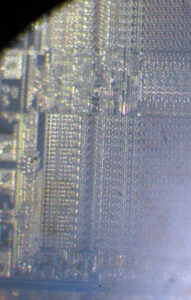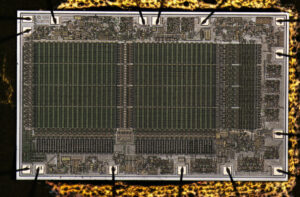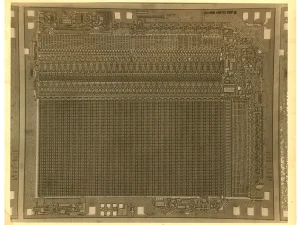The First Mass Produced DRAM of the Soviet Union
In 1966, American engineer and inventor Robert Dennard invented dynamic RAM cells – single-transistor cells, each bit of information is stored in the form of an electric charge of a capacitor. By that time, MOS technology was already capable of creating capacitors. The presence or absence of a charge on a capacitor represents one or zero bits of information. And the transistor can control the recording of the charge into the capacitor. At the time, Dennard was working on a six-transistor memory cell, so he could only devote his spare time to his new idea. After figuring out the intricacies of writing charge into a capacitor using a transistor and then reading it back through the same transistor, Dennard and IBM applied for a patent for single-transistor dynamic random-access memory.
However, the first commercially available dynamic memory chip, the 1103, released by Intel in October 1970, used three transistors per cell and separate lines to write and read data. A single-transistor circuit requires a sophisticated signal amplifier to read the data. It was impossible to implement such an amplifier on a chip with the technology available at that time. At the end of 1971, the 1103 became the best-selling semiconductor chip in the world. By 1972, 14 of the 18 mainframe manufacturers in the U.S., Europe, and Japan were using semiconductor memory instead of magnetic core memory. The first commercially available computer, the HP9800, was designed using the Intel 1103.
The first truly mass-produced dynamic memory chip in the USSR was the 565RU1, a random-access RAM with a capacity of 4096 bits and a 4096 X 1 organization. It is believed that the prototype for the 565RU1 was the 2107A chip released by Intel at the turn of 1973-74. There is some similarities in layout to the 2107A, but it certainly is not a direct copy.
The chip is comparable in technical characteristics to analogues TMS4060 from Texas Instruments and MM5280 from National Semiconductor. Therefore, the question of which of the chips was chosen for copying remains open. The Soviet chip, like its Western counterparts, had a three-transistor memory cell.
It was in this circuitry that it was produced for many years, although the same 2107A was replaced within a year after the start of production by the 2107B chip, which already had a single-transistor memory cell.
Posted in:
Memory








